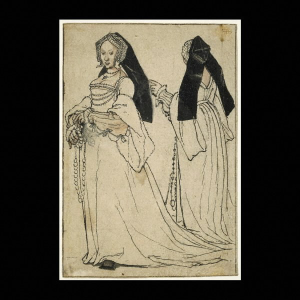An Early Tudor Outfit: Exploring the Evidence
Introduction
I've chosen 'Type 1' for my Sergeantry Quest and Elevation Garb; a dress in the style worn by Mary Wotton, Lady Guildford, in the iconic portrait by Holbein below. The first step is to explore how this dress might have been constructed, the possibilities of the entire outfit and a few peculiarities about early Tudor garb that I'm not sure will ever be solved.
Basic Evidence


Images from Wikimedia Commons. If you click on them, you'll be taken to a much larger version, in most cases.
The painting and drawing of Lady Mary show her wearing what seem to be at least three garments. One is a thin shift or smock with whitework and some tiny black stitches along the neckline. It's likely this was the undergarment for the whole ensemble. The next dress, or kirtle, has what looks to be some sort of gold embroidery around the edges of the neckline. This is visible in both the painting and the colored drawing. The kirtle is black or very dark navy in the painting. It's impossible to tell what kind of fabric it might be, although given the location (England) and the time frame it's likely to be wool. The colored drawing has another possible white kirtle on top of the black one, this is possibly just something the artist neglected to detail or color. This possible white kirtle is not shown in the painting. The third, and final, dress (gown) seems to be black velvet (or a rich wool), with some kind of furred, turned back sleeves. This gown forms the 'top' of the outfit.
Note that the linen of the smock, at the neckline, seems too sheer to form the white bits showing through the pleated orange silk lower sleeves and the cuffs. The cuffs, upon close examination, look as though they might feature whitework as well.
There is a thin linen (silk?) partlet, or necklace, over Mary's shoulders. In other portraits, including those from the time period from the Continent, this article is definitely a necklace (although some portraits show a partlet instead: the decision to wear a partlet or not might be one of fashion). There seems to be a distinct 'look' to the neckline and clothing of the period, which includes the very deliberate draping of the necklaces and/or wearing of a very thin partlet to achieve some of the same lines. Whether Mary wore a necklace or this was some kind of very thin partlet is unknown. It appears as a partlet in the painting and as a necklace in the drawing. I will be recreating it as a necklace, rather than a partlet.
Mary is wearing a strange white 'thing' which goes over her shoulders and down the sides of her body. There is much confusion about what this might be, and I must admit I do not know right now, and perhaps will never know for sure. However, that's not stopped me from doing a bit of research!
The under sleeves of the gown are silk, folded and pressed and otherwise fairly simple. The folding and pressing will be interesting. This sleeve style is quite popular at this period as evidenced from various British portraits. You will see some of them throughout this exploration.
The folded back black sleeves of the gown may be lined with velvet or wool or perhaps they are lined with a short fur of some kind. It's impossible to tell as the black of the gown doesn't allow much detail to be depicted. In the sketch the lining of the sleeves appears to be short fur.
Headdress and jewelry will be discussed later under accessories.
Sadly the portrait is not full length, and there is no possibility of knowing what the back of the dress looked like. However, Holbein and others did full-length portraits from time to time and there are some interesting sketches...

Image from the British Museum Collection
For example, the above sketch is another Holbein drawing, done some time between 1528 and 1530. The drawing is exciting because it shows both the front and back of an outfit very similar to that which Lady Wotton is wearing. The commentary for this sketch on the British Museum website suggests that wearer of the outfit in the drawing might be a lady in waiting, and not the person who would be wearing the garb for the portrait. So, my mind immediately wonders if this is the dress Mary Wotton is wearing. Note there are many similarities. This drawing shows that the sleeves are lined with some kind of fur. It also shows the back of the dress, at the neckline, is in a V shape and gives some seam lines.
The skirt is voluminous but not gathered too much at the front and sides (if at all). It has a long train. There are gathers at the back. Unlike later styles of dress, this dress does not split down the front, at least not in this depiction.
